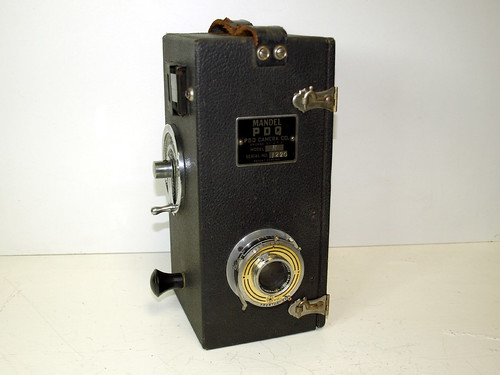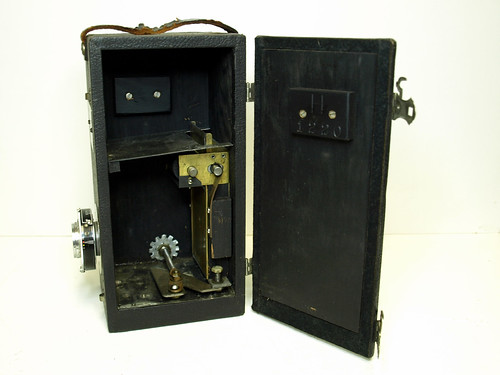Difference between revisions of "Mandel PDQ Camera"
m (→Links: US) |
m (mo' info) |
||
| Line 10: | Line 10: | ||
</div> | </div> | ||
| − | The '''Mandel PDQ Model H'' | + | The '''Mandel PDQ Model G''' and ''Model H'' are instant cameras, wooden-bodied cameras which used waterproof ''"Super Speed" direct-positive paper'' instead of film or plates.<ref>maybe a very special photo paper for a kind of [[ferrotype]] process was used, but no sources were cited, where this theory is given to this camera</ref> The unique camera type was made by the '''PDQ Camera Company''', formerly the [[Chicago Ferrotype Company]], owned by the brothers Louis and Manuel Mandel. |
It might be seen as the successor to the company's [[Mandel-ette]] camera; like that, the PDQ was intended for making quick, cheap portrait photographs, for example by street and fairground photographers. The PDQ has a better lens and shutter than the Mandel-ette however, and so would allow more flexibility of application than the earlier camera. The camera pictured here has a [[Schneider]] Radionar and Prontor-SV shutter, with speeds 1 to 1/200 second plus 'B' and 'T', a self-timer and a PC flash terminal. Another example with a 114mm f/4.5 [[Wollensak]] Raptar and Wollensak Betax shutter, with times 1/2 - 1/100 second, plus 'B' and 'T', was offered for sale at Westlicht;<ref name=W>[https://wlpa.auction2000.se/auk/w.Object?inC=WLPA&inA=20170531_1638&inO=355 PDQ Camera] with Wollensak lens and shutter; tank and nameplate missing; at the [https://wlpa.auction2000.se/auk/w.ObjectList?inSiteLang=&inC=WLPA&inA=20170531_1638 32nd Westlicht Photographica Camera Auction] in March 2018</ref> These are both front-element focusing lenses. | It might be seen as the successor to the company's [[Mandel-ette]] camera; like that, the PDQ was intended for making quick, cheap portrait photographs, for example by street and fairground photographers. The PDQ has a better lens and shutter than the Mandel-ette however, and so would allow more flexibility of application than the earlier camera. The camera pictured here has a [[Schneider]] Radionar and Prontor-SV shutter, with speeds 1 to 1/200 second plus 'B' and 'T', a self-timer and a PC flash terminal. Another example with a 114mm f/4.5 [[Wollensak]] Raptar and Wollensak Betax shutter, with times 1/2 - 1/100 second, plus 'B' and 'T', was offered for sale at Westlicht;<ref name=W>[https://wlpa.auction2000.se/auk/w.Object?inC=WLPA&inA=20170531_1638&inO=355 PDQ Camera] with Wollensak lens and shutter; tank and nameplate missing; at the [https://wlpa.auction2000.se/auk/w.ObjectList?inSiteLang=&inC=WLPA&inA=20170531_1638 32nd Westlicht Photographica Camera Auction] in March 2018</ref> These are both front-element focusing lenses. | ||
| Line 23: | Line 23: | ||
}} | }} | ||
</div>{{brr}} | </div>{{brr}} | ||
| − | After making an exposure, the crank on the side of the camera would be wound, to pass the exposed length of paper into the developing tank (attached to the bottom of the camera body, toward the rear). The knob below the crank would then be pulled out, against spring tension, to operate the knife to cut the paper. | + | After making an exposure, the crank on the side of the camera would be wound, to pass the exposed length of paper into the developing tank (attached to the bottom of the camera body, toward the rear). The knob below the crank would then be pulled out, against spring tension, to operate the knife to cut the paper. The new exposure then falls down into the small development cup which therefore must be attached below the camera back. The cup is shaped like a cigarette package, but made of stainless steel. |
All the examples of the camera seen are 'Model H', so it is not clear how other models differ, or if they exist. | All the examples of the camera seen are 'Model H', so it is not clear how other models differ, or if they exist. | ||
| Line 32: | Line 32: | ||
==Links== | ==Links== | ||
*[https://www.historiccamera.com/cgi-bin/librarium2/pm.cgi?action=app_display&app=datasheet&app_id=952 Mandel PDQ, Model G Camera] on historiccamera.com [https://www.historiccamera.com] | *[https://www.historiccamera.com/cgi-bin/librarium2/pm.cgi?action=app_display&app=datasheet&app_id=952 Mandel PDQ, Model G Camera] on historiccamera.com [https://www.historiccamera.com] | ||
| + | *[https://www.butkus.org/chinon/pdq/pdq_camera.htm manual and additional sources] in [https://www.cameramanuals.org/pdf_files/pdq_camera.pdf document] at butkus.org [https://www.butkus.org] | ||
{{chicago}} | {{chicago}} | ||
Revision as of 11:16, 1 November 2021

|
| Mandel PDQ Model H Instant Camera (developing tank missing) image by Mark Dalzell (Image rights) |
The Mandel PDQ Model G and Model H are instant cameras, wooden-bodied cameras which used waterproof "Super Speed" direct-positive paper instead of film or plates.[1] The unique camera type was made by the PDQ Camera Company, formerly the Chicago Ferrotype Company, owned by the brothers Louis and Manuel Mandel.
It might be seen as the successor to the company's Mandel-ette camera; like that, the PDQ was intended for making quick, cheap portrait photographs, for example by street and fairground photographers. The PDQ has a better lens and shutter than the Mandel-ette however, and so would allow more flexibility of application than the earlier camera. The camera pictured here has a Schneider Radionar and Prontor-SV shutter, with speeds 1 to 1/200 second plus 'B' and 'T', a self-timer and a PC flash terminal. Another example with a 114mm f/4.5 Wollensak Raptar and Wollensak Betax shutter, with times 1/2 - 1/100 second, plus 'B' and 'T', was offered for sale at Westlicht;[2] These are both front-element focusing lenses.

|
| View with left side open to show internals of the camera. "It used rolls of high speed direct positive paper and could be developed in about 2 minutes. The roll feeds down from the top and after the exposure is made, a crank on the side ejects the paper out of the bottom and a blade chops it off. The photo then falls into a developer bath (missing)." (cit. Mark Dalzell) image by Mark Dalzell (Image rights) |
After making an exposure, the crank on the side of the camera would be wound, to pass the exposed length of paper into the developing tank (attached to the bottom of the camera body, toward the rear). The knob below the crank would then be pulled out, against spring tension, to operate the knife to cut the paper. The new exposure then falls down into the small development cup which therefore must be attached below the camera back. The cup is shaped like a cigarette package, but made of stainless steel.
All the examples of the camera seen are 'Model H', so it is not clear how other models differ, or if they exist.
Notes
- ↑ maybe a very special photo paper for a kind of ferrotype process was used, but no sources were cited, where this theory is given to this camera
- ↑ PDQ Camera with Wollensak lens and shutter; tank and nameplate missing; at the 32nd Westlicht Photographica Camera Auction in March 2018
Links
- Mandel PDQ, Model G Camera on historiccamera.com [1]
- manual and additional sources in document at butkus.org [2]
| Companies of Chicago (Illinois) |
| Adams & Westlake | Central Camera Co. | American Advertising and Research Co. | Bernard | Burke & James | Busch | Calumet | Candid | Chicago Aerial | Chicago Camera Co. | Chicago Ferrotype Company | Deardorff | De Vry | Drucker | Galter | Geiss | Herold | Imperial | Kemper | Lennor Engineering Co. | Metropolitan Industries | Monarch | Montgomery Ward | Pho-Tak | QRS Company | Rolls | Sans & Streiffe | Sears | Seymour | Spartus | The Camera Man | United States Camera Co. | Western Camera Manufacturing Co. | Yale | Zar | Zenith |
| Chicago in depth: The Chicago Cluster, a bakelite trust? |